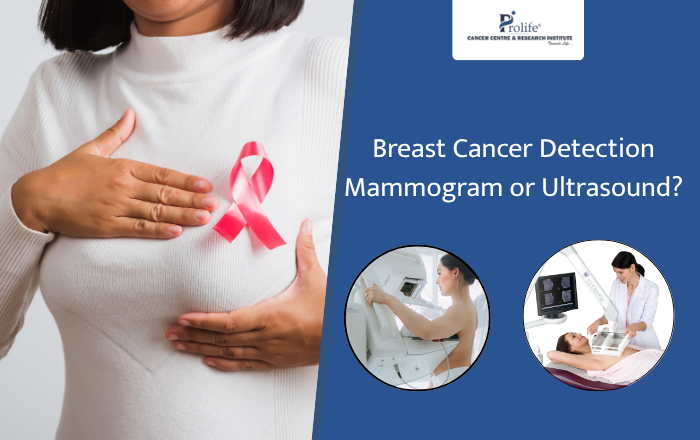If you’ve ever found a lump in your breast or your doctor recommends a scan, one question often comes up: Mammogram or ultrasound — which one is better at finding breast cancer?
It’s a fair question. Both tests are used to check for breast changes, but they work differently, and they’re not always interchangeable. The truth is, one isn’t better than the other in every situation. It depends on your age, breast density, symptoms, and what the doctor is looking for.
In this blog, we’ll break down exactly how each test works, when it’s used, and which one tends to be more effective in different cases — in plain language, without the medical jargon. By the end, you’ll have a much clearer idea of what these tests do and when they matter.
Mammogram vs Ultrasound: What’s the Actual Difference?
Both mammograms and ultrasounds are used to detect changes in breast tissue. But they’re very different in how they do it.
How a Mammogram Works
A mammogram is an X-ray image of the breast. It compresses the breast between two plates and takes images from different angles. This helps spot:
- Small lumps that can’t be felt
- Microcalcifications (tiny calcium deposits that might be linked to cancer)
- Tumors in early stages
It’s widely used for routine breast cancer screening, especially in women over 40.
How an Ultrasound Works
A breast ultrasound uses sound waves to create images of the inside of the breast. A handheld device (called a transducer) is moved across the skin, and the sound waves bounce off tissues inside the breast to form a picture.
It’s often used:
- As a follow-up test after a mammogram shows something unusual
- For younger women or those with dense breast tissue
- During pregnancy (since there’s no radiation)
When Is a Mammogram Recommended?
Mammograms are the go-to screening test for most women starting at age 40. Some women may need them earlier, especially if they have a family history of breast cancer or certain genetic factors.
A mammogram can often spot signs of cancer before any symptoms appear. That’s why doctors recommend regular screening even when you feel perfectly fine
When Is an Ultrasound Used?
Ultrasound is not typically used for routine screening, but it plays a key role in diagnosis.
Doctors might recommend it:
- If a lump is found during a physical exam
- To look closer at something seen on a mammogram
- For women with dense breast tissue (where mammograms may not be as clear)
- To see if a lump is solid or filled with fluid (like a cyst)
- If you’re under 30 or pregnant
So while ultrasounds are great for follow-up and clarification, they aren’t a substitute for a mammogram in most cases.
Which Test Detects Breast Cancer More Accurately?
It depends on the situation.
– Mammogram Accuracy
- Better at spotting early-stage tumors
- Picks up calcifications that can be early warning signs
- May miss tumors in women with dense breasts
– Ultrasound Accuracy
- More helpful in dense breasts, especially for spotting lumps
- Better at telling the difference between a cyst and a solid mass
- May miss small tumors or calcifications that a mammogram would catch
Pros and Cons at a Glance
| Test | Pros | Cons |
|---|---|---|
| Mammogram | Detects early-stage cancer, calcifications | Less effective for dense breasts |
| Ultrasound | No radiation, better for dense tissue, painless | May miss early signs, not for screening |
If you’re over 40 with no symptoms, a mammogram is usually the first step. If you’re younger, pregnant, or have dense breasts, an ultrasound might be added. And if there’s a lump or other concern, your doctor might use both.
Bottom line: don’t try to self-diagnose. You need the right scan for the right situation, and only a qualified medical team can decide what that is.
So, Which One Is Better?
This isn’t about picking a winner. It’s about using the right tool at the right time.
- Mammograms are great for spotting early signs — even when there are no symptoms.
- Ultrasounds are helpful for looking deeper once something is already found or if mammograms aren’t giving clear results.
- Sometimes, both are needed to get the full picture.
If you’re unsure about what you need — get it checked. Waiting and guessing helps no one.
FAQ: Mammogram vs Ultrasound
Q1. Is ultrasound better than a mammogram for dense breasts?
Yes. Ultrasound works better in dense breasts because it can detect lumps that mammograms might miss.
Q2. Can I skip a mammogram if I get an ultrasound?
No. Ultrasound doesn’t pick up early warning signs like microcalcifications. Mammograms are still the primary screening tool.
Q3. Which test is safer — mammogram or ultrasound?
Both are safe. Mammograms use low-dose radiation, and ultrasounds use sound waves. There’s no long-term harm from either.
Know What to Do Next – Get Checked Today
When it comes to breast health, knowledge is power — but only if you act on it.
If you’re in Pune and need clear answers or the right diagnostic approach, consider visiting Prolife Cancer Centre, a trusted cancer hospital in Pune. Dr. Sumit Shah and his team are known for guiding patients through breast cancer screening and diagnosis with clear information and timely action.
Whether you’re due for a routine scan or dealing with a new concern, don’t wait. Get the clarity you need — and take the next step toward peace of mind.



